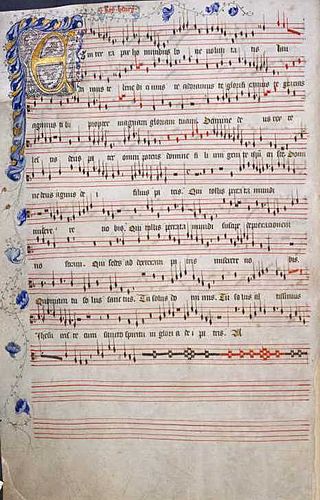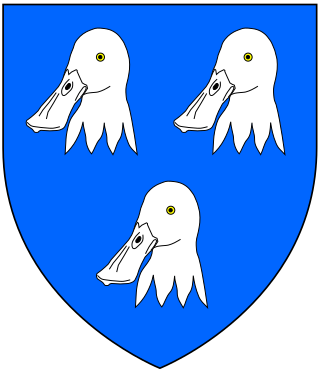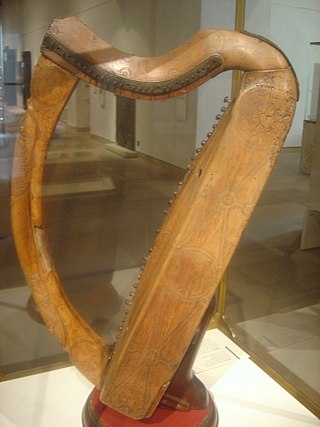Related Research Articles

Gilles de Bins dit Binchois was a Franco-Flemish composer of early Renaissance music. A central figure of the Burgundian School, Binchois and his colleague Guillaume Du Fay were deeply influenced by the contenance angloise style of John Dunstaple. His efforts in consolidating a 'Burgundian tradition' would be important for the formation of the Franco-Flemish School. One of the three most famous composers of the early 15th century, Binchois is often ranked behind Du Fay and Dunstable by contemporary scholars, but his works were still widely cited, emulated and used as source material after his death.
Christopher Urswick (1448–1522) was a priest and confessor of Margaret Beaufort. He was Rector of Puttenham, Hertfordshire, and later Dean of Windsor. Urswick is thought to have acted as a go-between in the plotting to place her son Henry VII of England on the throne.

John Dunstaple was an English composer whose music helped inaugurate the transition from the medieval to the Renaissance periods. The central proponent of the Contenance angloise style, Dunstaple was the leading English composer of his time, and is often coupled with William Byrd and Henry Purcell as England's most important early music composers. His surviving music is exclusively vocal, and frequently uses isorhythms, while pioneering the prominent use of harmonies with thirds and sixths. His style would have an immense influence on the subsequent music of continental Europe, inspiring composers such as Du Fay, Binchois, Ockeghem and Busnois.

Jehan de Lescurel was a composer-poet of late medieval music. Jehan's extensive surviving oeuvre is an important and rare examples of the formes fixes before the time of Guillaume de Machaut; it consists of 34 works: 20 ballades, 12 rondeaus and two long narrative poems, diz entés. All but one of his compositions is monophonic, representing the end of the trouvère tradition and the beginning of the polyphonic ars nova style centered around the formes fixes.

Isorhythm is a musical technique using a repeating rhythmic pattern, called a talea, in at least one voice part throughout a composition. Taleae are typically applied to one or more melodic patterns of pitches or colores, which may be of the same or a different length from the talea.
Leonel Power was an English composer of the late Medieval and early Renaissance music. Along with John Dunstaple, he was a dominant figure of 15th century English music. Primarily a composer of sacred music, Power is the best represented contributor in the Old Hall Manuscript.

The Old Hall Manuscript is the largest, most complete, and most significant source of English sacred music of the late 14th and early 15th centuries, and as such represents the best source for late Medieval English music. The manuscript somehow survived the Reformation, and formerly belonged to St. Edmund's College, a Roman Catholic school located at Old Hall Green in Hertfordshire. It was sold to the British Library after an auction at Sotheby's in 1973.
Byttering was an English composer during the stylistic transitional from medieval to Renaissance music. Five of his compositions have survived in the Old Hall Manuscript, where the musicologist Peter Wright contends they "form a small yet distinctive corpus of work notable for its technical ambition and musical accomplishment".

Antonio "Zacara" da Teramo was an Italian composer, singer, and papal secretary of the late Trecento and early 15th century. He was one of the most active Italian composers around 1400, and his style bridged the periods of the Trecento, ars subtilior, and beginnings of the musical Renaissance.

Windsor Castle is a royal residence at Windsor in the English county of Berkshire. It is strongly associated with the English and succeeding British royal family, and embodies almost a millennium of architectural history.
William Wynford or William of Wynford was one of the most successful English master masons of the 14th century, using the new Perpendicular Gothic style.
Johannes Alanus was an English composer. He wrote the motet Sub arturo plebs/Fons citharizancium/In omnem terram. Also attributed to him are the songs "Min frow, min frow" and "Min herze wil all zit frowen pflegen", both lieds, and "S'en vos por moy pitié ne truis", a virelai. O amicus/Precursoris, attributed simply to "Johannes", may be the work of the same composer.

Edmund Lacey was a medieval Bishop of Hereford and Bishop of Exeter in England.
James Goldwell was a medieval Dean of Salisbury and Bishop of Norwich.
Margaret Bent CBE, is an English musicologist who specializes in music of the late medieval and Renaissance eras. In particular, she has written extensively on the Old Hall Manuscript, English masses as well as the works of Johannes Ciconia and John Dunstaple.

St George's Chapel at Windsor Castle in England is a castle chapel built in the late-medieval Perpendicular Gothic style. It is both a Royal Peculiar and the Chapel of the Order of the Garter. St George's Chapel was founded in the 14th century by King Edward III and extensively enlarged in the late 15th century. It is located in the Lower Ward of the castle. The castle has belonged to the monarchy for almost 1,000 years and was a principal residence of Elizabeth II before her death. The chapel has been the scene of many royal services, weddings and burials – in the 19th century, St George's Chapel and the nearby Frogmore Gardens superseded Westminster Abbey as the chosen burial place for the British royal family. The running of the chapel is the responsibility of the dean and Canons of Windsor who make up the College of Saint George. They are assisted by a clerk, verger and other staff. The Society of the Friends of St George's and Descendants of the Knights of the Garter, a registered charity, was established in 1931 to assist the college in maintaining the chapel.

Music in Medieval Scotland includes all forms of musical production in what is now Scotland between the fifth century and the adoption of the Renaissance in the early sixteenth century. The sources for Scottish Medieval music are extremely limited. There are no major musical manuscripts for Scotland from before the twelfth century. There are occasional indications that there was a flourishing musical culture. Instruments included the cithara, tympanum, and chorus. Visual representations and written sources demonstrate the existence of harps in the Early Middle Ages and bagpipes and pipe organs in the Late Middle Ages. As in Ireland, there were probably filidh in Scotland, who acted as poets, musicians and historians. After this "de-gallicisation" of the Scottish court in the twelfth century, a less highly regarded order of bards took over the functions of the filidh and they would continue to act in a similar role in the Scottish Highlands and Islands into the eighteenth century.
Nicholas Sturgeon was a Canon of Windsor from 1442 to 1454, a composer and a compiler of the Old Hall Manuscript.
Francis Pigott was an English Baroque composer and organist.
Magister Franciscus was a French composer-poet in the ars nova style of late medieval music. He is known for two surviving works, the three-part ballades: De Narcissus and Phiton, Phiton, beste tres venimeuse; the former was widely distributed in his lifetime. Modern scholarship disagrees on whether Franciscus was the same person as the composer F. Andrieu.
References
Citations
Sources
- Bent, Margaret (2001). "Damett" . Grove Music Online . Oxford: Oxford University Press. doi:10.1093/gmo/9781561592630.article.07123. ISBN 978-1-56159-263-0.(subscription or UK public library membership required)
- Strohm, Reinhard (2005). The Rise of European Music, 1380-1500. Cambridge: Cambridge University Press. ISBN 978-0-521-61934-9.